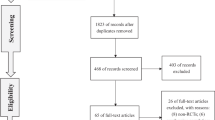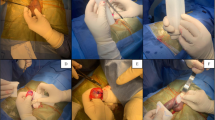Abstract
Erectile dysfunction (ED) is a common complication after radical prostatectomy and results from trauma sustained by the cavernosal nerves. This is a major concern for patients and often affects treatment decisions. The likely mechanism for post-prostatectomy ED is through corporal veno-occlusive dysfunction. There is an increasing amount of evidence to suggest that phosphodiesterase 5 inhibitors (PDE5 inhibitors), when given on a continuous long-term basis, can help to prevent and reverse ED after surgery. In this review article we will examine the pathophysiology of post-prostatectomy ED and discuss the experimental and available clinical evidence for administering PDE5 inhibitors after prostatectomy.
This is a preview of subscription content, access via your institution
Access options
Subscribe to this journal
Receive 8 print issues and online access
$259.00 per year
only $32.38 per issue
Buy this article
- Purchase on Springer Link
- Instant access to full article PDF
Prices may be subject to local taxes which are calculated during checkout



Similar content being viewed by others
References
DeFrances CJ, Hall MJ . 2002 National Hospital Discharge Survey. Advance Data from Vital and Health Statistics; no. 342. National Center for Health Statistics: Hyattsville, MD, 2004 Adv Data 2004; 21: 1–29.
Montorsi F, Burnett AL . Erectile dysfunction after radical prostatectomy. BJU Int 2004; 93: 1–2.
Mulhall JP, Slovick R, Hotaling J, Aviv N, Valenzuela R, Waters WB et al. Dysfunction after radical prostatectomy: hemodynamic profiles and their correlation with the recovery of erectile function. J Urol 2002; 167: 1371–1375.
Menon M, Kaul S, Bhandari A, Shrivastava A, Tewari A, Hemal A . Potency following robotic radical prostatectomy: a questionnaire based analysis of outcomes after conventional nerve sparing and prostatic fascia sparing techniques. J Urol 2005; 174: 2291–2296, discussion 2296.
Quinlan DM, Epstein JI, Carter BS, Walsh PC . Sexual function following radical prostatectomy: influence of preservation of neurovascular bundles. J Urol 1991; 145: 998–1002.
Catalona WJ, Carvalhal GF, Mager DE, Smith DS . Potency, continence and complication rates in 1870 consecutive radical retropubic prostatectomies. J Urol 1999; 162: 433–438.
Stanford JL, Feng Z, Hamilton AS, Gilliland FD, Stephenson RA, Eley JW et al. Urinary and sexual function after radical prostatectomy for clinically localized prostate cancer: the Prostate Cancer Outcomes Study. JAMA 2000; 283: 354–360.
Penson DF . The effect of erectile dysfunction on quality of life following treatment for localized prostate cancer. Rev Urol 2001; 3: 113–119.
User HM, Hairston JH, Zelner DJ, McKenna KE, McVary KT . Penile weight and cell subtype specific changes in a post-radical prostatectomy model of erectile dysfunction. J Urol 2003; 169: 1175–1179.
Rajfer J, Rosciszewski A, Mehringer M . Prevalence of corporeal venous leakage in impotent men. J Urol 1988; 140: 69–71.
Melman A, Gingell JC . The epidemiology and pathophysiology of erectile dysfunction. J Urol 1999; 161: 5–11.
Mulhall JP, Graydon RJ . The hemodynamics of erectile dysfunction following nerve-sparing radical retropubic prostatectomy. Int J Impot Res 1996; 8: 91–94.
Leungwattanakij S, Bivalacqua TJ, Usta MF, Yang DY, Hyun JS, Champion HC et al. Cavernous neurotomy causes hypoxia and fibrosis in rat corpus cavernosum. J Androl 2003; 24: 239–245.
Moreland RB . Pathophysiology of erectile dysfunction: the contributions of trabecular structure to function and the role of functional antagonism. Int J Impot Res 2000; 12: S39–S46.
Ferrini MG, Davila HH, Kovanecz I, Sanchez SP, Gonzalez-Cadavid NF, Rajfer J . Vardenafil prevents fibrosis and loss of corporal smooth muscle that occurs after bilateral cavernosal nerve resection in the rat. Urology 2006; 68: 429–435.
Kovanecz I, Rambhatla A, Ferrini MG, Vernet D, Sanchez S, Rajfer J et al. Long term sildenafil treatment ameliorates corporal veno-occlusive dysfunction (CVOD) induced by cavernosal nerve resection in rats. Int J Impot Res 2007 Prel acceptance.
Gonzalez-Cadavid NF, Rajfer J . The pleiotropic effects of inducible nitric oxide synthase on the physiology and pathology of penile erection. Curr Pharm Des 2005; 11: 4041–4046.
Midrio M . The denervated muscle: facts and hypotheses. A historical review. Eur J Appl Physiol 2006; 98: 1–21.
Valente EG, Vernet D, Ferrini MG, Qian A, Rajfer J, Gonzalez-Cadavid NF . L-arginine and phosphodiesterase (PDE) inhibitors counteract fibrosis in the Peyronie's fibrotic plaque and related fibroblast cultures. Nitric Oxide 2003; 9: 229–244.
Magee TR, Ferrini M, Garban HJ, Vernet D, Mitani K, Rajfer J et al. Gene therapy of erectile dysfunction in the rat with penile neuronal nitric oxide synthase. Biol Reprod 2002; 67: 1033–1041.
Zhou X, Frohlich ED . Analogy of cardiac and renal complications in essential hypertension and aged SHR or L-NAME/SHR. Med Chem 2007; 3: 61–65.
Okazaki H, Minamino T, Tsukamoto O, Kim J, Okada K, Myoishi M et al. Angiotensin II type 1 receptor blocker prevents atrial structural remodeling in rats with hypertension induced by chronic nitric oxide inhibition. Hypertens Res 2006; 29: 277–284.
Boffa JJ, Lu Y, Placier S, Stefanski A, Dussaule JC, Chatziantoniou C . Regression of renal vascular and glomerular fibrosis: role of angiotensin II receptor antagonism and matrix metalloproteinases. J Am Soc Nephrol 2003; 14: 1132–1144.
Tarsitano CA, Paffaro Jr VA, Pauli JR, da Silva GH, Saad MJ, Salgado I et al. Hepatic morphological alterations, glycogen content and cytochrome P450 activities in rats treated chronically with N(omega)-nitro-L-arginine methyl ester (L-NAME). Cell Tissue Res 2007; 329: 45–58.
Criado M, Flores O, Vazquez MJ, Esteller A . Role of prostanoids and nitric oxide inhibition in rats with experimental hepatic fibrosis. J Physiol Biochem 2000; 56: 181–188.
Hochberg D, Johnson CW, Chen J, Cohen D, Stern J, Vaughan Jr ED et al. Interstitial fibrosis of unilateral ureteral obstruction is exacerbated in kidneys of mice lacking the gene for inducible nitric oxide synthase. Lab Invest 2000; 80: 1721–1728.
Chen Y, Hozawa S, Sawamura S, Sato S, Fukuyama N, Tsuji C et al. Deficiency of inducible nitric oxide synthase exacerbates hepatic fibrosis in mice fed high-fat diet. Biochem Biophys Res Commun 2005; 326: 45–51.
Ferrini MG, Davila H, Valente EG, Gonzalez-Cadavid NF, Rajfer J . Aging-related induction of inducible nitric oxide synthase (iNOS) is vasculo-protective in the arterial media. Cardiovascular Res 2004; 61: 796–805.
Ferrini MG, Vernet D, Magee TR, Shahed A, Quian A, Rajfer J et al. Antifibrotic role of inducible nitric oxide synthase (iNOS). Nitric Oxide 2002; 6: 283–294.
Davila HH, Magee TR, Rajfer J, Gonzalez-Cadavid NF . Gene therapy with the inducible nitric oxide synthase (iNOS) cDNA regresses the fibrotic plaque in an animal model of Peyronie's disease. Biol Reprod 2004; 71: 1568–1577.
Ferrini MG, Kovanecz I, Nolazco G, Rajfer J, Gonzalez-Cadavid NF . Effects of long-term vardenafil treatment on the development of fibrotic plaques in a rat model of Peyronie's disease. BJU Int 2006; 97: 625–633.
Bojunga J, Dresar-Mayert B, Usadel KH, Kusterer K, Zeuzem S . Antioxidative treatment reverses imbalances of nitric oxide synthase isoform expression and attenuates tissue-cGMP activation in diabetic rats. Biochem Biophys Res Commun 2004; 316: 771–780.
Brock G, Nehra A, Lipshultz LI, Karlin GS, Gleave M, Seger M et al. Safety and efficacy of vardenafil for the treatment of men with erectile dysfunction after radical retropubic prostatectomy. J Urol 2003; 170: 1278–1283.
Lowentritt BH, Scardino PT, Miles BJ, Orejuela FJ, Schatte EC, Slawin KM et al. Sildenafil citrate after radical retropubic prostatectomy. J Urol 1999; 162: 1614–1617.
Schwartz EJ, Wong P, Graydon RJ . Sildenafil preserves intracorporeal smooth muscle after radical retropubic prostatectomy. J Urol 2004; 171: 771–774.
Montorsi F, Nathan HP, McCullough A, Brock GB, Broderick G, Ahuja S et al. Tadalafil in the treatment of erectile dysfunction following bilateral nerve sparing radical retropubic prostatectomy: a randomized double-blind, placebo controlled trial. J Urol 2004; 172: 1036–1041.
Vignozzi L, Filippi S, Morelli A, Ambrosini S, Luconi M, Vannelli GB et al. Effect of chronic tadalafil administration on penile hypoxia induced by cavernous neurotomy in the rat. J Sex Med 2006; 3: 419–431.
Author information
Authors and Affiliations
Corresponding author
Rights and permissions
About this article
Cite this article
Rambhatla, A., Kovanecz, I., Ferrini, M. et al. Rationale for phosphodiesterase 5 inhibitor use post-radical prostatectomy: experimental and clinical review. Int J Impot Res 20, 30–34 (2008). https://doi.org/10.1038/sj.ijir.3901588
Received:
Revised:
Accepted:
Published:
Issue Date:
DOI: https://doi.org/10.1038/sj.ijir.3901588
Keywords
This article is cited by
-
The two phases of the clinical validation of preclinical translational mechanistic research on PDE5 inhibitors since Viagra’s advent. A personal perspective
International Journal of Impotence Research (2019)
-
Increased expression of nestin in the major pelvic ganglion following cavernous nerve injury
International Journal of Impotence Research (2012)
-
On-demand use of erectile aids in men with preoperative erectile dysfunction treated by whole gland prostate cryoablation
International Journal of Impotence Research (2011)
-
Bulbocavernosus reflex testing: a preliminary study on the prognostic factors for potency and response to sildenafil citrate after bilateral nerve-sparing radical prostatectomy
International Urology and Nephrology (2010)
-
Penile change following radical prostatectomy: Size, smooth muscle atrophy, and curve
Current Urology Reports (2008)



